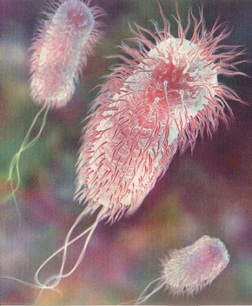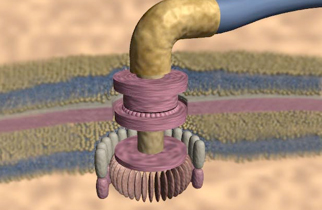You’ve probably heard of nanobots, but did you know that nature has some nanobots of its own? Ever wonder how tiny organisms like bacteria move around? It’s hard to move at the nanoscale but bacteria like E. coli can do it by using a tail-like thing called a flagellum that they rotate using a molecular motor.
The molecular motor that spins a flagellum is made up of proteins that self assemble. The bacterium makes these proteins, ships them to the surface and then these proteins assemble to make a motor. But how to power this motor? To power the motor the bacteria uses a form of fuel known as ATP (adenosine triphosphate). ATP is sort of like a battery for biological systems, even people have ATP in our cells.
T here are lots of ways to make ATP from sugar and other things that serve as food for bacteria. The ATP can then be used to power molecular motors. It takes one ATP molecule to move a motor one-quarter of a turn. So a bacteria needs lots of ATP to move. When it’s running, this molecular motor can turn almost a thousand times per minute. That is about the same speed as a car engine when it is idling. These motors produce about 10-15 watts of power.
here are lots of ways to make ATP from sugar and other things that serve as food for bacteria. The ATP can then be used to power molecular motors. It takes one ATP molecule to move a motor one-quarter of a turn. So a bacteria needs lots of ATP to move. When it’s running, this molecular motor can turn almost a thousand times per minute. That is about the same speed as a car engine when it is idling. These motors produce about 10-15 watts of power.
What’s a watt? Watts measure of how much energy is spent in a certain amount of time, so 10-15 doesn’t sound like a lot of watts (think about a 60 watt lightbulb). But on a weight basis bacteria are 200 times more powerful swimmers compared to people!
Scientists are starting to build molecular motors through studying chemistry and physics of real molecular motors. They then can build them out of parts from bacteria and assemble them under a microscope where they can watch them work. It is still not really practical but someday maybe we will be able to make little machines powered by bacteria.

